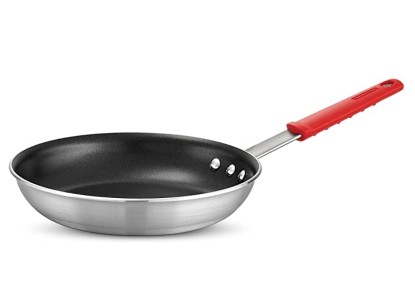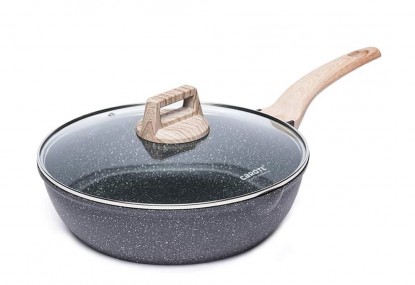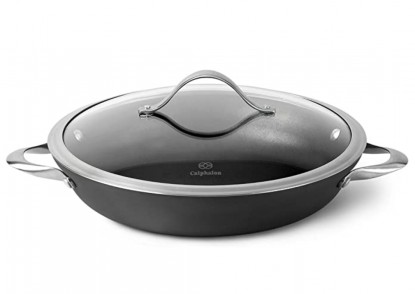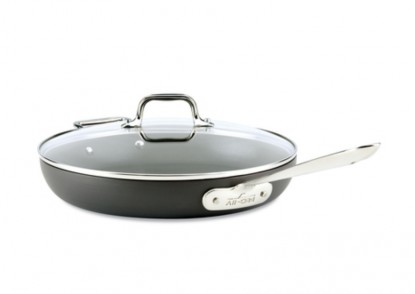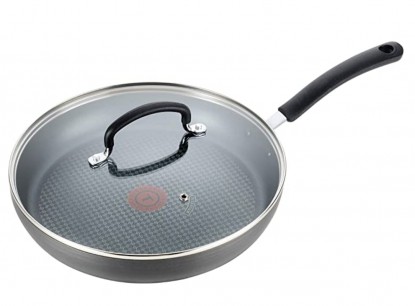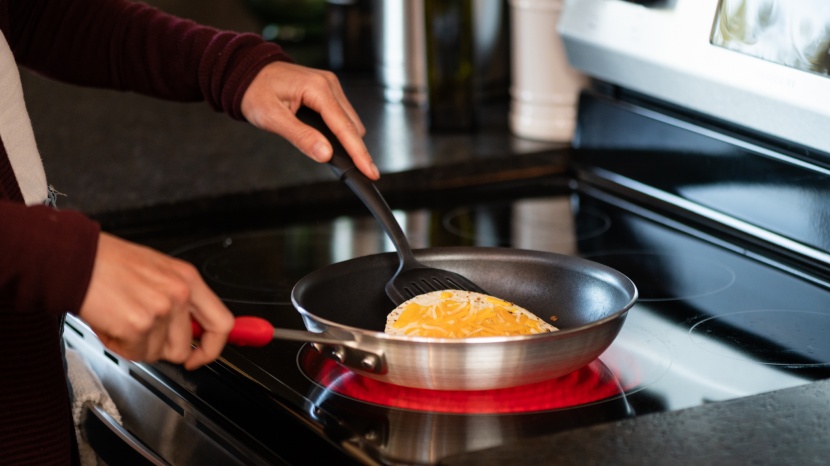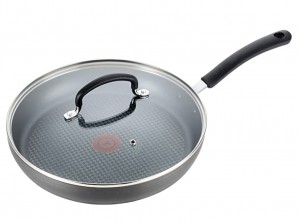Picking a nonstick pan can be a tall order. Our culinary team researched, purchased, and tested 9 of the best nonstick pans on the market. Our comparative analysis covers all of the common uses of this type of cookware — such as searing fish, flipping pancakes, and folding omelets — and rates each model's performance. We also evaluated the materials used and the construction quality of these products so you can be sure that they are reliable and durable. The result of our work is detailed in the following review. Our aim is for this report to make it much easier to pick the right pan for your needs and budget.
From materials to functionality, there are a dizzying number of options when it comes to choosing cookware. That's why our reviews run the gamut from the top-rated pot holders to woks and the best electric and stove-top griddles. Whether you're a newbie looking to outfit your kitchen with the best cookware set or a seasoned home chef interested in a top-rated sous vide, there's something for all levels of expertise.
Our Top Picks
9 Best Nonstick Pans
The Tramontina Pro Series 10 in is hard to beat. This pan is durable. It's coated with three layers of industrial-strength Whitford Corp Eclipse fluoropolymer, and it has the National Sanitation Foundation (NSF) certification. This pan also has near-flawless anti-stick properties. Never before have we used a spatula so little when making eggs and pancakes. The metal handle comes equipped with a removable silicone cover, so there's little concern for burns, and the lack of food build-up in the skillet results in quick and easy cleaning.
While we like the handle cover, this nonstick pan is prone to tipping off small burners when empty due to the appendage's length and weight. We also found that food could become stuck around the rivets that connect the handle, which can make cleanup more difficult. Aside from these minor critiques, we were quite impressed with the performance of the professional-grade Tramontina as perfect pancakes, eggs, and fish steaks slid onto the plate without the slightest resistance or residue remaining in the pan.
Of the stone cookware tested for this review, the Ozeri 8" Stone Earth frying pan produced results competitive with the best pans in the class. This pan is on the smaller end of the group, making it perfect for fried eggs and omelets. We didn't have any sticking issues with food when testing omelets, fish, or pancakes, which we could flip without the aid of a spatula.
The main issue we encountered was the tight diameter coupled with the relatively steep sides made it hard to use a spatula if, for example, a pancake filled most of the cooking surface. Additionally, the three rivets that attach the handle tend to hold food that would otherwise slide right out of the skillet. Issues aside, we were pleased with the performance of this nonadhesive surface as cleaning was a breeze, and the plated food was restaurant quality.
The Carote 9.5-in Deep Fry Pan With Glass Lid sets itself apart from the competition as a more versatile piece of cookware. The lid and the deep sides make it possible to use the pan like a wok and a frying pan. The angle of the sides promotes pan tosses of mixed veggies and searing meats. The lack of rivets securing the handle result in less work when it's time to clean up, as there are no weak points in the pan interior for food to grab onto and harden. Finally, the addition of a lid makes steaming and low heat simmering possible.
The design offers a wider range of applications, but the generalist nature also means that it doesn't do any one thing particularly well. For instance, the middling volume of the pan does not accommodate large servings. At the same time, the deep sides make it more difficult to slide the spatula blade under eggs and pancakes. Also, the composite handle limits the oven-safe temperature to 350º F. Compared to its traditional nonstick counterparts, the stone coating rendered below average results. Limitations aside, the Carote offers home cooks various cooking options, filling in the gaps left open by traditional cookware sets.
If you're willing to pay for premium craftsmanship and durability, there is no better choice than the Scanpan HaptIQ 8" frying pan. Scanpan takes design and construction seriously. This pan is built to stand up to heavy use and metal utensils from the 5-layer recycled aluminum and stainless steel body to the professional-grade Stratanium+ nonadhesive coating to the mirror polish exterior. The pan is also oven-safe up to 500º F while offering superior heat distribution when on the range. There are no harmful chemicals in the surface material, and the nonstick performance is without peer. Case in point, we did not need a spatula when flipping or removing pancakes, omelets, and fish.
Our only major gripe here is the cost. The asking price of this pan is several times higher than other high-performing models. Moreover, with the attention to detail that Scanpan displays in the design and manufacturing, they could have eliminated the rivet heads securing the handle to the pan. The problem here is that the rivet heads present a weak point in the cooking surface where food can adhere. Aside from these minor points, we think this pan (and the company that makes it) is exceptional and worth the cost. We're inclined to remind those looking for inexpensive cookware that when you buy cheap, you often buy twice.
Although the Le Creuset 10 1/4" Signature Skillet is not a true nonadhesive pan, we included it in our analysis as a point of comparison. We found it to be quite competitive in certain areas, and it offered a great deal more uses than the other models in the class. For one, the enamel coating is super durable, capable of handling the highest of heats. The cast iron core of the pan also offers superior heat distribution and recovery. This means that the surface maintains its temperature even when food is added that would otherwise cool that surface.
Despite the benefits of cast iron and enamel, the surface is not nearly as effective at releasing food as most coated pans. For instance, the Le Creuset is decidedly not an omelet pan and was the only product we reviewed to fail that test. Without butter or oil, pancakes and seared fish stuck to the pan. Due to the heavy 5 lbs 6 ounces weight, pan tosses are nearly impossible. Lastly, it's quite expensive. However, this pan is truly oven-safe at the highest heat, making it possible to cook both on the stovetop and under the broiler. Le Creuset cookware is extremely durable; we often see them passed down as heirlooms or fetching high prices at thrift stores, which helps mitigate the initial sticker shock.
The Calphalon Contemporary Everyday Pan 12" is excellent for making big meals. One of the primary frustrations that we experienced with the other frying pans in the class was that their diameters limited the amount of food we could cook at one time — mainly when it came to pancakes. The included lid and oven-safe rating of 450º F further expands the culinary applications of this pan. The nonstick coating is sufficient, though it wouldn't hurt to grease the pan for delicate items such as eggs or fish.
Unfortunately, the Contemporary struggled in our stick tests, which were conducted without grease. While the results were not catastrophic, we experienced issues with fish and eggs slightly adhering though we could still flip and fold an omelet. Another problem we encountered was that the heat transferred to the loop handles, requiring us to use a potholder when working the pan's contents. With that said, this pan was excellent for whipping out large numbers of pancakes in a hurry and slow simmers of red sauces where sticking/burning has to be avoided. All and all, this pan is a go-to for big meals.
The All-Clad HA1 12" with Lid is a heavy-weight in the class of nonstick cookware. It's hefty, to be sure, but its weight is in large part due to its large diameter of 12 ⅛" and the 8 ¾" handle. For those looking to make large meals, it should be an easy choice. The pan also comes standard with a glass lid, thus adding to the diversity of cooking techniques it can accommodate. Both the pan and lid are rated to 500º F in the oven — a real benefit for those tackling involved recipes.
As is often the case, a product's advantages can also be disadvantages in some situations. For instance, the dimensions of this pan require more real estate than many ranges or kitchens may offer, and its long handle can easily get bumped in a busy kitchen. When placed on a small burner, the heat distribution is poor across the wide cooking surface. Given its proportions, it is not surprising that our testers preferred other options for pan flipping foods, such as omelets. The generous cooking surface is advantageous for some meals, like pouring in multiple pancakes. Finally, the nonadhesive coating is decent but not great, likely requiring grease over time. Despite our critiques, the All-Clad performed admirably and will satisfy most users considering the competitive price.
When cooking eggs, particularly omelets, the smaller pans in the class have a distinct advantage, and the Anolon Advanced 8" is no exception. This 8 ½" skillet with flared walls makes pan tossing eggs, pancakes, and even fish a breeze. The nonstick coating worked wonders on even the most sticky foods in our tests.
On the flip side, the Anolon is reasonably limited. It doesn't come with a lid, and despite its oven-safe rating, its “sure grip” handle isn't suited for use in the oven. Finally, its three layers of nonstick coatings do not inspire confidence for long-term durability, as the surface showed some wear after our testing was complete. Despite these shortcomings, we think that this pan is an excellent choice for a dedicated egg pan, as the finished product will come sliding out onto a plate with little to no resistance.
The T-Fal Ultimate Hard Anodized 10" is more of a sauté pan than a frying pan. As such, it didn't thrive in the tests we ran it through (i.e., pancakes, omelets, and searing fish). This is mostly because the pan has tall, vertical sides. When used for appropriate tasks, such as making sauces, deep-frying, and — you guessed it — sautéing, the pan performs well.
While we thought that this pan had some interesting features that we wanted to add to our comparative analysis, we were not completely sold on the pan's quality. The aluminum seems a bit flimsy, and the heat indicator at the center of the cooking surface is a bit gimmicky. Lastly, the T-fal's food release performance declined continuously throughout the testing process. This issue was most notable when searing tuna. A significant amount of crispy residue remained in the pan following the flip, which required a spatula, unlike some of the competition. Despite its misgivings, when used for the right tasks, we think there is a place for this sauté pan in many kitchens.
Why Trust GearLab
This review began with a thorough analysis of the leading nonstick pans on the market. Over 100 products were researched, consumer comments were read, and professional insight was sought from a line chef and a short-order cook. After careful deliberation, the candidates were selected and purchased for hands-on testing. Once the products arrived in our lab, our team got to work cooking the stickiest foods they could think of—foods where a quality nonstick surface is largely what stands between professional and mediocre outcomes.
Seasoned cookware experts Michelle Powell and Nick Miley led this review of nonstick pans. Collectively, this pair has over 25 years of culinary experience in both professional and home cooking theaters. Michelle has been a competitive barista, baker, and café manager throughout her career, while Nick has been called an obsessive home cook and baker. Whether it's searing fresh caught Mahi Mahi for the family following a successful fishing trip or folding crepes for a Sunday brunch rush, these two are overly familiar with the value of a high-quality nonstick surface in a busy kitchen.
Analysis and Test Results
Our evaluation of nonadhesive pans, specifically their food release performance, relied on three recipes that are best made on a nonstick surface. Namely, these are sourdough pancakes, country omelets, and seared yellowfin steaks. These foods are both sticky and delicate. As we did not grease any of the pans during testing, the desired outcome depended solely on the nonadherent quality of the pan's coating. Additionally, we assessed the ease of use, including size, weight, dimensions, number of plies of coating, whether a lid is included, and the cleaning difficulty. The following is a rundown of the tests' details and the best-performing products.
Pancakes
One of our favorite breakfast treats is sourdough buttermilk pancakes. These tasty morsels are best rendered light and fluffy with a thin golden-brown crust on either side. The great benefit of a quality nonstick pan with this recipe is that it eliminates the need for grease that can make the cake soggy. At the same time, the cakes will have a smooth, even crust. Excelling at this task, the Tramontina, Ozeri, and Scanpan all met the highest standard of being able to lightly shake loose the cake, flip it, and then slide it onto a plate, all without the use of a spatula. The Anolon, Carote, and Calphalon were close seconds, requiring a slight budge to break their bond with the cooking surface.
Each pan was heated for 10 minutes before pouring one cup of batter onto the non-greased surface. The first cake was not scored but was used to ensure the correct temperature. We made both blueberry and plain cakes, making four cakes in total. Their scores are on a scale of one through five. A score of one was a total failure. Two meant the cake stuck to the pan and fell apart when a spatula was used. Few of the products received such low marks. Most fell into the three to four range, meaning the cake stuck but maintained its integrity when flipped, or better yet, it was quickly freed with a spatula. A true five could cook the cake from batter to plate without using a spatula, such as the Scanpan.
Omelettes
There are many ways to cook an omelet. However, we focused on a country-style method that flips the egg cake before adding the filling and folding it when the underside is done. Scored similarly to the pancake test described above, the omelet test revealed which pans' coatings effectively resisted the adherence of foods heavy in proteins and fat. Given their past performance, it should be no surprise that the Scanpan and the Tramontina dished out professional results. They flipped the egg cake with ease. Meanwhile, the Anolon showed that the small diameter pans offer a distinct advantage for shaping, flipping, and folding so long as their coating was up to the task.
Like the pancake test, we were looking for pans that required little input from our spatula to release the food, with the highest score going to pans that needed a spatula only to fold the egg over the filling. The dreamy Scanpan epitomized this score. A score of one, such as was given to the Le Creuset, is a complete failure, as the egg was irreparably bonded with the ungreased pan.
Fish
While not necessarily the stickiest, yellowfin is the most delicate of the three foods used to test the pans in this review. Additionally, the searing method we used to render the tuna steaks called for the highest heat of the three recipes. Thus, the moisture and oil released from the muscle quickly dry and harden in every tiny crease, crack, and pore. With only the slightest bit of residual marks on the pan and almost no outstanding adhesion, the Tramontina and the Scanpan topped the charts, with the Ozeri following close behind with a bit more stick. Though, no utensil was needed to free the steak for the flip.
As this recipe calls for searing, we heated the pan to “searing hot,” which is medium-high on most stoves. We allowed ten minutes of preheating for the heavy-bottomed pans, such as the Le Creuset. Five to eight minutes was enough for the other models. The steaks were placed in the center of the cooking surface and timed to 1 minute and 30 seconds per side before removing. Those pans that did not require utensils to release the fish were highly rated. Those that retained a big chunk of fish on their surface received lower scores, such as the Calphalon. None of the pans utterly failed, but the Le Creuset surprised us all, outperforming many of the true nonstick pans in this evaluation.
Ease of Use
Our ease of use evaluation assesses the features and performance of the pans under review and how, as a whole, they impact the user experience. Specifically, we delve into the difficulty of cleaning, pan dimensions, weight, whether it comes with a lid, and the number of plies of nonstick coatings. The last item on this list speaks to the pan's durability as all nonstick coatings wear and fail in time. While all the pans have appealing ease of use features, none more so than the Tramontina. Thanks to its light weight, removable rubber panhandle, diameter, and sidewall angle, this pan is just lovely to use.
While the Tramontina has three nonstick coatings, the Scanpan boasts five plies, making it arguably the most durable and easiest to use for the most extended period. For those looking for more real estate than these pans offer, both the Calphalon and the All-Clad have over 113 square inches of cooking area and come standard with glass lids — a definite boon if you're looking to simmer with a pan.
The Carote is an interesting pan, as it has equally strong pros and cons weighing on its ease of use. The lack of a riveted handle makes cleaning simple since the nonstick coating is unbroken throughout the pan's interior. It has a lid, and it's lightweight. However, the tall and steep sidewalls make it hard to flip eggs and the like.
Conclusion
This review provides a complete analysis of nonstick pans. Our hands-on tests use three recipes that are greatly benefited by the prevention of adhesion between the food and cooking surface. These are country omelets, buttermilk pancakes, and seared tuna steaks. After cooking dozens of these courses, we can definitively say which pans performed best and why. The above analysis is curated to make direct comparisons as easy as possible so that one can make their next nonstick frying pan selection with ease and accuracy. With that in mind, here's to showy pan tosses, perfectly fried eggs, and the satisfaction of a good home-cooked meal. Bon appétit.
—Nick Miley



